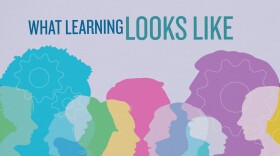Editor's note: This story has been updated to clarify the ages of the subjects in the SDSU study.
In third grade, Brokton Harris was standing on the playground at school, watching his classmates play tag. He saw five boys running after another boy, trying to tag him.
“So I started chasing them and yelling at them, and ended up sending one of them to the nurse’s office for one reason or another,” said Brokton, now 17 years old.
“No, you sent five kids to the nurse’s office,” his mom, Chantelle Harris, interjected. “These were fifth-graders and he was in third grade.”
And he had beaten up all of them.
But Brokton was not and is not a delinquent. What he saw on the playground that day looked very different from what other kids saw.
Brokton has Asperger’s syndrome, now known as high-functioning autism. People with autism, whether mild like Brockton’s or more severe, have trouble reading and responding appropriately to social cues.
RELATED: What Learning Looks Like: Creating A Well-Tuned Orchestra In Your Head
New research out of the SDSU Center for Autism helps paint a picture of what was going on in Brokton’s head that day — and what might be going on in the brains of all individuals when they make a social gaffe. The findings, published in the Journal of the American Academy of Child & Adolescent Psychiatry, also inch scientists closer to finding a key biological marker that would make diagnosing the disorder easier and improve patient outcomes.
“Many labs and many scientists are trying to understand what I call the ‘black box,’” said Inna Fishman, a clinical neuropsychologist and associate research professor at San Diego State University. “The way we understand and diagnose autism spectrum today is entirely based on behavior. We don’t actually have good — or really (any) — understanding of what distinguishes children on the spectrum (biologically) from other typically developing children.”
So Fishman and her colleagues scanned the brains of 105 seven- to 17-year-olds. About half had autism and half did not. They paid particular attention to the amygdala, a part of the brain that sort of runs triage.
“Whether it’s a friendly face or a piece of music that I hear, the amygdala serves as a filter for marking for the brain, ‘OK, this is important. I better pay attention to it,’” Fishman said.
The team found weak connections between the amygdala and the visual cortex in the children with autism.
“So it was communicating less, with the regions in the back of the brain that are responsible for visually detecting facial cues, smiles, facial expressions, eye gaze, things that are really important for social communication, which is really an area of weakness for kids on the spectrum,” Fishman said.
So when Brokton saw these kids running after their classmate — playing tag — whether they had smiles or grimaces on their faces didn’t make it past his amygdala, what Fishman compared to a gate. All that his brain processed was five big kids chasing one little kid, so it told him to step in.
“He’s the type of kid who likes to look out for the little guy,” Chantelle said.
Things were made worse because, once Brokton stepped in, he couldn’t stop swinging. Fishman’s findings offer some context here, too.

“During adolescence, the connections between the amygdala and the prefrontal cortex, which really governs our behavior, strengthens dramatically in neurotypical development,” she said. “We were really surprised to find that this strengthening of connections was completely absent in teens on the spectrum, and it was even reversed in the left hemisphere.”
Fishman described the prefrontal cortex as the brain’s brake system. Teens with autism don’t appear to be pumping the brakes as often as they should, she said.
RELATED: What Learning Looks Like: The Art And Science Of Classroom Transitions
Whether these patterns exist when children with autism are born, or develop over time because children with autism are unable to exercise these brain connections, is unknown. But Fishman and her students have very early results that suggest the former.
They’ve devised a way to scan the brains of toddlers while they’re sleeping. While the findings have not yet been peer reviewed or published, they show very similar patterns.
Fishman said she hopes this research leads to something more concrete than behavior that will let doctors diagnose children with autism earlier. While specialists can diagnose autism before age two, the average age of diagnosis is age four, Fishman said.
“And why is that important? Because what we know today is that the best course of action, the best interventions and treatment, are the ones that start early on,” Fishman said. “This is a lifelong disorder, and that has huge societal implications, not to mention individual implications, (for) the families, educational systems, our economy.”

Chantelle was eager to tell her and Brokton’s story, because she’s felt those implications.
After the incident on the playground, Brokton spiraled. Chantelle thought he would have to be put into a mental health facility. Instead, the family uprooted everything and took a financial hit to move Brokton to a farm in Tennessee where he could reset.
“You start to feel very isolated. You start to feel very alone and like it will never end, like it’s not going to ever get better.” Chantelle said. “Is all this work that I’m doing helping?”
But the work she and family put in to fix those weak circuits has helped. Brokton, who plays flag football at school and is learning to drive, stills needs some reminders about social cues, but most of the rewiring he’s doing these days is on old electronics and his scooter. He hopes to become an engineer.






